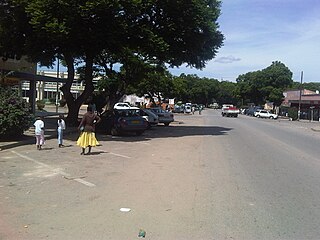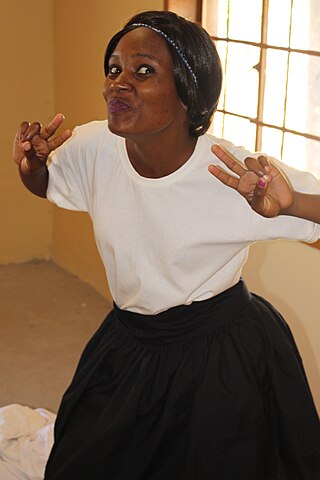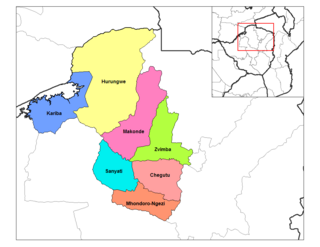
Masvingo, previously named Victoria, is a province in southeastern Zimbabwe. It has a population of 1.638 million as of the 2022 census, ranking fifth out of Zimbabwe's ten provinces. Established by the British South Africa Company, it was one of the five original provinces of Southern Rhodesia. In 1982, two years after Zimbabwean independence, it was renamed Masvingo Province. The province is divided into seven districts, including Masvingo District, which contains the provincial capital Masvingo City.

Rusape is a town in eastern Zimbabwe.
The Ndau are an ethnic group indigenous to south-eastern Zimbabwe in the districts of Chipinge and Chimanimani. They are also found in parts of Bikita, in the Zambezi valley, in central Mozambique until the coast and in central Malawi. Their presence in these regions was documented as early as the 1500s by Portuguese missionary João dos Santos. The etymology of the name "Ndau" has multiple interpretations. In their own language, "Ndau" means "land", similar to how the neighboring Manyika people's name translates to "Owners of the Land". The phrase "Ndau yedu" in the Ndau language means "our land", with an alternative etymology suggesting that the name derives from the Nguni words "Amading'indawo", meaning "those looking for a place", reportedly used by the Gaza Nguni to describe them.
A paramount chief is the English-language designation for a King/Queen or the highest-level political leader in a regional or local polity or country administered politically with a chief-based system. This term is used occasionally in anthropological and archaeological theory to refer to the rulers of multiple chiefdoms or the rulers of exceptionally powerful chiefdoms that have subordinated others. Paramount chiefs were identified by English-speakers as existing in Native American confederacies and regional chiefdoms, such as the Powhatan Confederacy and Piscataway Native Americans encountered by European colonists in the Chesapeake Bay region of North America.
Kanyemba is a village in the province of Mashonaland Central, Zimbabwe. It is located on the south bank of the Zambezi river at the extreme northernmost point of Zimbabwe at the meeting point of the Zimbabwean, Mozambican and Zambian borders. The village serves the Dande communal land.

Tsholotsho, originally known as Tjolotjo, is a district in Matabeleland North province in Zimbabwe. Its administrative centre is at Tsholotsho business centre which is located about 98 km north-west of Bulawayo. Districts around Tsholotsho include Lupane, Hwange, Umguza, and Bulilima. The Manzamnyama River separates Tsholotsho from Bulilima District, whilst the Gwayi River separates it from Umguza and Lupane districts, and the Hwange National Park separates it from Hwange District.
Aeneas Soko Chigwedere was a Zimbabwean politician, historian, educationist, and traditional leader. He served as the Minister of Education, Sports, & Culture since August 2001, and was appointed the Resident Minister and Governor of Mashonaland East Province in August 2008. He was installed as Headman Svosve Mubayiwa on 10 March 2008. On 22 January 2021, he died at his farm near Marondera following COVID-19 related complications during the COVID-19 pandemic in Zimbabwe.
Bernard Mizeki was an African Christian missionary and martyr. Born in Mozambique, he moved to Cape Town, attended an Anglican school, and became a Christian.
Gurajena is ahieftainship which was reduced to Headman during the colonial Era in the Masvingo Province of Zimbabwe. It is located about 60 km north east of Masvingo and can be reached by following Zimuto Road north and then branching off at Maraire shopping centre to go due north east and crossing the Munyambe River, which is the border between Gutu and Zimuto, just before reaching the shopping centre. It is almost exactly due east of Gwengwerere Growth Point, Zimbabwe. It was named after Chief Gurajena whose Chieftainship still lay unclaimed ever since he was dethroned during the white colonial rule. It is one of the oldest growth points in the areas. There are several villages under Chief Gurajena and most of the land for this chieftainship was taken by the then white farmers nicknamed Chimunyanja and Kurutu.

Mberengwa, originally known as Belingwe, is a district in Midlands province in Zimbabwe. The district is now divided into sub-districts: Mberengwa North, East, West and South. It is bounded by Gwanda in Mberengwa west, and by Zvishavane in its northern zone, to the south it stretches to Neshuro, Chikombedzi and bounded by Manyuchi dam.

The Tonga people of Zambia and Zimbabwe are a Bantu ethnic group of southern Zambia and neighbouring northern Zimbabwe, and to a lesser extent, in Mozambique. They are related to the Batoka who are part of the Tokaleya people in the same area, but not to the Tonga people of Malawi. In southern Zambia they are patrons of the Kafue Twa. They differ culturally and linguistically from the Tsonga people of South Africa and southern Mozambique.
Zimbabwean art includes decorative esthetics applied to many aspects of life, including art objects as such, utilitarian objects, objects used in religion, warfare, in propaganda, and in many other spheres. Within this broad arena, Zimbabwe has several identifiable categories of art. It is a hallmark of African cultures in general that art touches many aspects of life, and most tribes have a vigorous and often recognisable canon of styles and a great range of art-worked objects. These can include masks, drums, textile decoration, beadwork, carving, sculpture, ceramic in various forms, housing and the person themselves. Decoration of the body in permanent ways such as scarification or tattoo or impermanently as in painting the body for a ceremony is a common feature of African cultures.
Buhera is a village in Zimbabwe.

The Kalanga or BaKalanga are a southern Bantu ethnic group mainly inhabiting Matebeleland in Zimbabwe, northern Botswana, and parts of the Limpopo Province in South Africa.

Shava is an animal totem variant of the Mhofu/Mpofu, which is the name of the eland deer-like animal in Southern Africa. Shava is often associated with describing pruness, ware and tier becoming self-sufficient, such as by hunting or fishing.

Zvimba District is a district of Mashonaland West Province, Zimbabwe.
Uzumba-Maramba-Pfungwe, also known as UMP, is a district of Mashonaland East Province in Zimbabwe. It consists of the northern part of the pre-1969 larger Murehwa (Mrehwa) District and includes the village of Uzumba. The area is inhabited by the Budja Shona people. The staple food crop is maize, with secondary vegetable crops.
Mangwende is a dynasty from Southern Africa, Zimbabwe commonly known as Mangwende dynasty of Nhowe or Mangwende of Nhowe. It is the royal dynasty of the Nhowe people, who are a part of the Shona tribe now living in Murewa, Mashonaland East, Zimbabwe. The Mangwende dynasty was started by the patriarch of the Nhowe people, Sakubvunza in 1606 who established the Shona traditional state of Nhowe. The name Nhowe refers to the traditional state as well as the Nhowe people.

The Yeke Kingdom of the Garanganze people in Katanga, DR Congo, was short-lived, existing from about 1856 to 1891 under one king, Msiri, but it became for a while the most powerful state in south-central Africa, controlling a territory of about half a million square kilometres. The Yeke Kingdom also controlled the only trade route across the continent from east to west, since the Kalahari Desert and Lozi Kingdom in the south and the Congo rainforest in the north blocked alternative routes. It achieved this control through natural resources and force of arms—Msiri traded Katanga's copper principally, but also slaves and ivory, for gunpowder and firearms—and by alliances through marriage. The most important alliances were with Portuguese–Angolans in the Benguela area, with Tippu Tip in the north and with Nyamwezi and Swahili traders in the east, and indirectly with the Sultan of Zanzibar who controlled the east coast traders.
Helen Mangwende was a leader in Women's Clubs during the 20th century. Mangwende influenced many African women during a time of white minority rule. Mangwende's creation of The Federation of African Women Clubs gave African women opportunities that would not have existed through normal colonial domestic education. Mangwende's efforts showed African and colonial women that they could work together to help each other.








